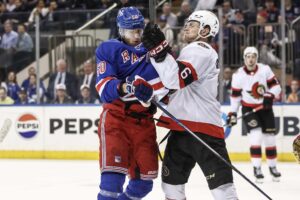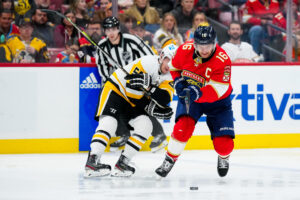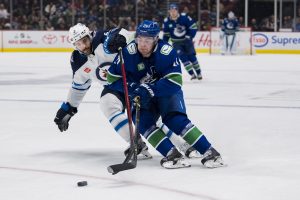The History of Trade is a mini series going through each team’s best and worst trades of all time. Each team has their own history and some may cross over, but the series will try to stick to each team. This article will focus on the Montreal Canadiens trade history, finding the best and worst of all time.
For a team that’s been around for longer than the NHL itself, the Montreal Canadiens have a truly historic trade history. From acquiring the picks that turned into stars and stars that turned into legends, you can find it all with a Canadiens logo attached. The history is filled with lots of good, and of course lots of bad.
Best Trade
Many teams don’t even have as many trades as the Canadiens have blockbusters, both bad and good. Acquiring the likes of Ken Dryden and Toe Blake as well as the pick that turned into Max Pacioretty and of course Patrick Roy will do that for you. But that biggest trade may have brought the original flower to La Belle Province.
The Trade
Montreal acquires Francois Lacombe, 1971 first round pick (Guy Lafleur), and cash from the California Golden Seals for Ernie Hicke, and 1970 first round pick (Chris Oddleifson)
Traded Away
Getting a first round pick in the NHL isn’t easy. But giving up a first round pick and a player for a first round pick and a player is even more surprising. But somehow the Canadiens brass managed to pull it off. The Montreal management was looking ahead by a year and decided that their three first round picks (5,6, and 10 overall) were not good enough. Having traded for California’s first round pick almost three years prior for the rights to Danny O’Shea, Montréal knew they had a potential suitor.
The deal saw Hicke and the tenth overall selection head to the Golden Coast. Hicke would have a good year in 1970, putting up a respectable 22 goals and 47 points in his rookie season. Unfortunately his sophomore season would have different results. He put up almost half of his rookie production, scoring just 11 goals and 23 points by seasons end. It was not what the Seals were hoping for. The next off season saw Hicke be selected by the Atlanta Flames in the expansion draft, thus ending his California career. He would spend the next six seasons bouncing around the league. But this trade would always be his defining moment.
The first round pick that Montreal sent to California turned into Chris Oddleifson. Oddleifson would never have the opportunity to play for the club as he was sent to Boston along with Rich LeDuc for Ivan Boldirev. He would struggle in Boston and would have to wait until his third full season in the league to score more than 40 points. But his career was less than expected as the tenth overall pick.
The Return
Putting the draft pick and story behind it aside, the other piece to the trade was Francois Lacombe. Lacombe was actually a Canadien at one point. But before playing for the team he was trade to California in 1968. Fast-forward two years and Lacombe had played 74 games across two seasons with the Golden Seals. He amasses 2 goals and 18 points in those two years as a defenseman.
After arriving in Montreal for the second time Lacombe would not be able to unpack before the Buffalo Sabres selected him in the 1970 expansion draft. He would play only one game in Buffalo, recording an assist before his NHL career was put on pause. Lacombe continued to play for seven seasons in the WHA for the Quebec Nordiques and Calgary Cowboys.
He would eventually return to the NHL with the Nordiques in 1979-80 but only managed to play in three games before being sent to the AHL and eventually retiring.
As far as the pick went, Montreal’s management team knew exactly what they were doing. 1971 was going to be the year of the French-Canadian in the draft as the top two picks looked to both be from Quebec. The Los Angeles Kings started the season off even worse than the Seals; tt looked like the pick would end up as the second overall instead of the first.
In order to change the fortunes of the league Sam Pollock, then General Manager of the Canadiens, made a trade that sent Ralph Backstrom to LA in exchange for Gord Labossiere and Ray Fortin. Backstrom was able to turn LA from the last place team to the sixth worst team in just 37 games. This was the key in Montreal’s plan as their new first round pick was now first overall.
Pollock was infatuated with Lafleur, so naturally “The Flower” was selected first, ahead of fellow future hall of famer Marcel Dionne. The rest, as they say, is history. Lafleur would go on to put up 64 points in his rookie season and would reach the 100 point mark just three years later. From 1975-76 seasons until the 1979-80 season, Lafleur would score 50+ goals and 125+ points in each year. He won three consecutive Art Ross trophies, 3 consecutive Pearson Awards, and 2 straight Hart trophies. Of course he added the 1976-77 Conn Smythe trophy just for fun.
He would spend another five seasons in Montreal, never scoring less than 70 points except in 1984-85 when, in shocking fashion, he retired mid season. His “retirement” would last all of three and a half years before his yearning pulled him back to the game. He would return to the league as only the second player ever to play after being named to the Hockey Hall of Fame. He signed with the New York Rangers though and never returned to Montreal.
When his career as a Canadien was over he stood alone on the peaks of their players. The franchise leader in assists and points and second in goals to only the great Maurice Richard, Lafleur has gone down as one of the greatest players to ever don the Canadiens crest. He was named to the NHL’s Top 100 players list last season. Lafleur was also named as an honourable mention (behind the aforementioned Richard) in our Canadiens All-Time Lineup.
Honourable Mentions: Montreal acquires Josh Gorges and 2007 first round pick (Max Pacioretty) from the San Jose Sharks for Craig Rivet and 2008 fifth round pick (Julien Demer), Montreal trades Paul Reid and Guy Allen to the Boston Bruins for Ken Dryden and Alex Campbell, the Canadiens acquire Toe Blake, Bill Miller, and the rights to Ken Grivel from the Toronto Maple Leafs for Lorne Chabot, Montreal trades Robert Picard to the Winnipeg Jets for the 1984 third round pick (Patrick Roy)
Worst Trade
For a team with countless great trades, they were bound to have a few duds. Montreal is no exception. But somehow there worst trade not only made them weaker, but also made the other team a Stanley Cup champion not once, but twice.
The Trade
Montreal Trades Patrick Roy and Mike Keane to the Colorado Avalanche for Jocelyn Thibault, Andrei Kovalenko, and Martin Rucinsky.
Traded Away
For the second time in this series we are talking about this trade, but for good reason. It changed the landscape in the NHL drastically.
Mike Keane may have just been the throw in piece for Colorado but it worked out well in the end for both him and the club. In the remaining games of the 1995-96 season, Keane would score 10 goals and 10 assists. Although not out of this world numbers, his contributions helped get the Avs to the playoffs; with a little help from Roy of course. He would also pitch in five points during the playoff run that year on the way to the Stanley Cup. Keane would only last one more season in Colorado before signing as a free agent with New York. He may never have experienced the scoring output he had in Montreal but his two years in Colorado were definitely successful.
Roy on the other hand didn’t miss a beat after being traded. Prior to the trade Roy was already an all star and legend in the making. He broke into the league in 1985-86 with a 23 win season. He would only fail to reach that mark twice for the rest of his career: once the following year and the second time during the lockout shortened 1994-95 season in which he still won 17 games. Even more incredible, during his first five full seasons in the league, Roy managed to improve his save percentage each year from .875 all the way up to .912. his 12 years in Montreal saw him average a .904 save percentage and a 2.77 goals against average. He also managed 289 wins in that time, placing him second in franchise history behind only the legendary Jacques Plante.
After arriving in Colorado half way through the 1995-96 season Roy just continued to roll. He managed 22 wins in 39 games after the trade while holding a 2.68 goals against average. His playoff presence in Montreal also carried over to Colorado. He lead the new team to the Stanley Cup final in their first season in Denver, and eventually helped them raise it. His .921 save percentage and 2.10 goals against average was even better than his prior Stanley Cup winning numbers.
But somehow, despite the unbelievable numbers Roy put up in his first half season they paled in comparison to the rest of his Colorado career. He would never have a save percentage lower than .913 in any season while maintaining a 2.39 goals against average or better each year. His crowning season came in 2000-01. Roy won the most games of his career, 40, while posting a 2.21 save percentage during the regular season. His playoff numbers though, were otherworldly. In 23 games Roy would win 16 while posting a .934 save percentage and a ridiculous 1.70 goals against average. The Avs would win their second Stanley Cup in franchise history and Roy was named the Conn Smythe winner.
His next season saw the best regular season numbers of his career as well. Despite only winning 32 games, Roy would post a .925 save percentage and 1.94 goals against average. To say he was on his game was an understatement. Roy would retire an Av with two Stanley Cups and 262 wins. He remains the franchise leader in wins (262), save percentage (.918), and goals against average (2.27). Roy was named to the Hockey Hall of Fame and last season was named one of the NHL’s Top 100 players of all time. He was also named to our list of the Colorado Avalanche All-Time Lineup as the starting goalie.
The Return
Montreal really messed this trade up. Kovalenko had shown positive signs in Quebec and Colorado. But he only managed to finish out the 1995-96 season with Montreal. He scored 17 goals and added 17 assists in 51 games after joining the club. Kovalenko was traded to Edmonton during the next offseason for Scott Thornton who was more known for being an enforcer than a goal scorer.
Rucinsky was the other position player Montreal gained during the trade. The difference here in Rucinsky actually played well for the Canadiens. He managed 60 points in 56 games after joining the team. The problem was that was his highest point total during his time in Montreal. He would put up point totals of 55, 53, 34, 49, and 38 during his remaining five years in Montreal. Rucinsky would be traded early the next year to the Dallas Stars along with two other players for Shaun Van Allen.
Then there is Jocelyn Thibault. A former first round pick, 10th overall, Thibault was supposed to be the replacement for a legend. Those are big shoes to fill obviously. But Thibault had the ability. He even showed it in the two years prior to the trade. He managed to drop his 3.31 goals against average in his first year all the way down to 2.34 in his second year. Yes, he did play nine less games in year two but the results were there.
After only ten games in Colorado in 1995-96, Thibault packed his bags and headed to Montreal with the weight of a franchise waiting for him. He played admirably the rest of the season, winning 23 games. Thibault also posted a .913 save percentage and a 2.83 goals against average as well. His success in Montreal would be limited, never reaching the 23 win total again. But his personal numbers were still strong. He managed a career .908 save percentage and a 2.73 goals against average across his four seasons in Montreal. But unless he had become a perennial Vezina trophy candidate, Thibault was never going to be a success in Montreal.
Now, everyone knows Roy forced the teams hand in this trade. After being removed very late into a game he made it clear he wasn’t going to play for the Habs again. But despite the rushed effort to trade the legend, The Canadiens brass definitely missed their mark on this one.
Dishonourable Mentions: Montreal trades Chris Chelios and a 1991 second round pick (Michael Pominter) to the Chicago Blackhawks for Denis Savard, Montreal trades Pierre Turgeon, Rory Fitzpatrick, and Craig Conroy to the St. Louis Blues for Shayne Corson, Murray Baron, and a 1997 fifth round pick (Gennady Razin), Montreal trades Rogie Vachon to the Los Angeles Kings for Denis DeJordy, Dale Hoganson, Noel Price and Doug Robinson, Montreal trades Rod Langway, Doug Jarvis, Craig Laughlin, and Brian Engblom to the Washington Capitals for Ryan Walter and Rick Green, Montreal trades Eric Desjardins, Gilbert Dionne, and John LeClair to the Philadelphia Flyers for Mark Recchi and a 1995 third round pick (Martin Hohenberger)
Main Photo:
Embed from Getty Images






